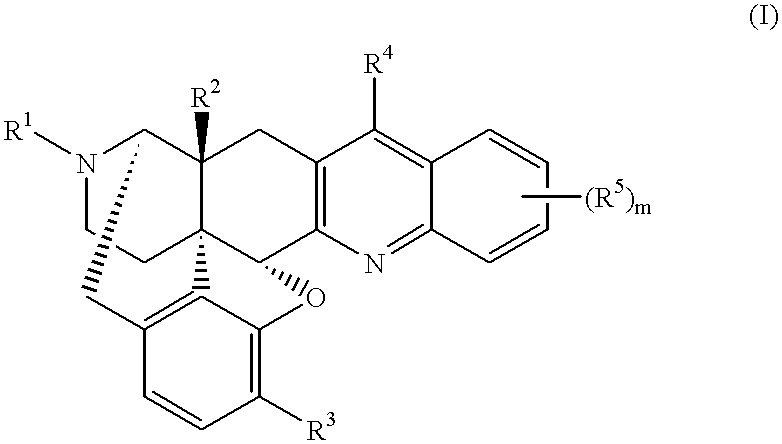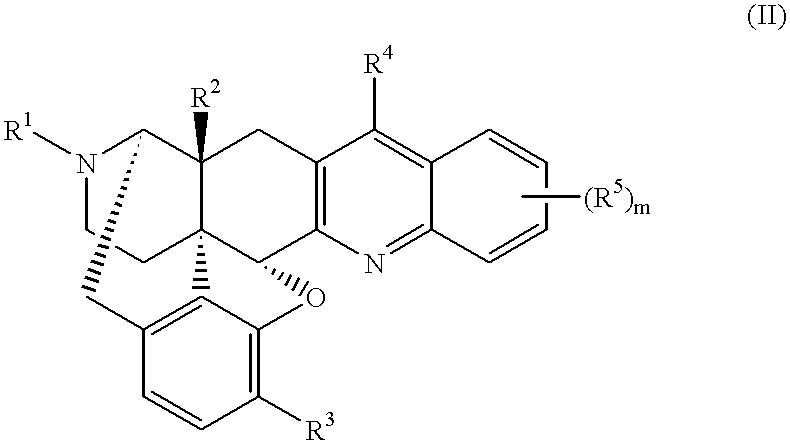Quinolinomorphinane derivatives and medicinal use thereof
a technology of quinolinomorphinane and derivatives, applied in the field of agents, can solve the problems of no medicine effective against damage to cerebral nerve cells, affecting the treatment effect of patients, so as to prevent the recurrence of cerebral disorders, cure or prevent the worsening of cerebral disorders, and improve the effect of disorders
- Summary
- Abstract
- Description
- Claims
- Application Information
AI Technical Summary
Benefits of technology
Problems solved by technology
Method used
Image
Examples
reference example 1
17-cyclopropylmethyl-6,7-dehydro-4,5.alpha.-epoxy-3,14.beta.-dihydroxy-6,7,2',3'-quinolinomorphinan 1.methanesulfonate
This compound was synthesized in accordance with the method disclosed in U.S. Pat. No. 4,816,586. 4.69 g (12.4 mmol) of 17-cyclopropylmethyl-6-oxo-4,5.alpha.-epoxy-3,14.beta.-dihydroxymorphinan hydrochloride, and 3.0 g of o-aminobenzaldehyde were added to 100 ml of ethanol, and 0.81 ml (12.4 mmol) of methanesulfonic acid was added to the resultant mixture, followed by heating under reflux for 2.5 hours. The reaction solution was concentrated under reduced pressure, and an aqueous saturated sodium hydrogencarbonate solution to the resultant residue, followed by extraction with ethyl acetate. The organic layers were together dried over anhydrous sodium sulfate, and then concentrated. Methanol was added to the residue to obtain 4.12 g (yield 78%) of free title compound as crystals. The thus-obtained compound was dissolved in methanol, and methanesulfonic acid was added ...
reference example 2
17-cyclopropylmethyl-6,7-dehydro-4,5.alpha.-epoxy-14.beta.-hydroxy-3-methoxy-6,7,2',3'-(7',8'-benzoquinolino)morphinan 2.methanesulfonate
3.18 g (7.75 mmol) of 17-cyclopropylmethyl-6-oxo-4,5.alpha.-epoxy-14.beta.-hydroxy-3-methoxy-7-[(dimethylamino)methylene] morphinan produced in accordance with the method disclosed in the document [J. Med. Chem., 24, 1445 (1981)] was dissolved in 15 ml of trifluoroacetic acid, and 5.57 g (31.0 mmol) of .alpha.-naphthylamine hydrochloride was added to the resultant solution, followed by stirring under heating at 120.degree. C. After 3 ml of trifluoroacetic acid was distilled off, the residue was heated under reflux at 120.degree. C. for 23 hours. After the reaction solution was concentrated, an aqueous saturated sodium hydrogencarbonate solution was added to the residue, followed by extraction with chloroform. The organic layers were together dried over anhydrous sodium sulfate, and then concentrated. The obtained crude product was purified by mediu...
reference examples 3-7
In accordance with the method of Reference Example 2, 4-methoxyaniline, 2-phenylaniline, 1-amino-5,6,7,8-tetrahydronaphthalene, 4-methylaniline, and 4-(dimethylamino)aniline hydrochloride were used in place of .alpha.-naphthylamine hydrochloride to obtain 17-cyclopropylmethyl-6,7-dehydro-4,5.alpha.-epoxy-14.beta.-hydroxy-3-methoxy-6,7,2',3'-(6'-methoxyquinolino)morphinan 3, 17-cyclopropylmethyl-6,7-dehydro-4,5.alpha.-epoxy-14.beta.-hydroxy-3-methoxy-6,7,2',3'-(8'-phenylquinolino)morphinan 4, 17-cyclopropylmethyl-6,7-dehydro-4,5.alpha.-epoxy-14.beta.-hydroxy-3-methoxy-6,7,2',3'-(7',8'-cyclohexenoquinolino)morphinan 5, 17-cyclopropylmethyl-6,7-dehydro-4,5.alpha.-epoxy-14.beta.-hydroxy-3-methoxy-6,7,2',3'-(6'-methylquinolino)morphinan 6, and 17-cyclopropylmethyl-6,7-dehydro-4,5.alpha.-epoxy-14.beta.-hydroxy-3-methoxy-6,7,2',3'-[6'-(dimethylamino)quinolino]morphinan 7, respectively.
PUM
| Property | Measurement | Unit |
|---|---|---|
| Volume | aaaaa | aaaaa |
| Volume | aaaaa | aaaaa |
| Energy | aaaaa | aaaaa |
Abstract
Description
Claims
Application Information
 Login to View More
Login to View More - R&D
- Intellectual Property
- Life Sciences
- Materials
- Tech Scout
- Unparalleled Data Quality
- Higher Quality Content
- 60% Fewer Hallucinations
Browse by: Latest US Patents, China's latest patents, Technical Efficacy Thesaurus, Application Domain, Technology Topic, Popular Technical Reports.
© 2025 PatSnap. All rights reserved.Legal|Privacy policy|Modern Slavery Act Transparency Statement|Sitemap|About US| Contact US: help@patsnap.com



